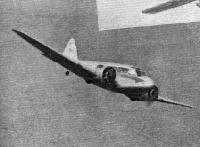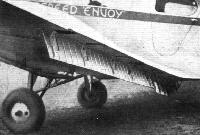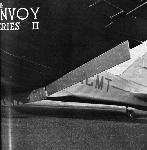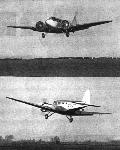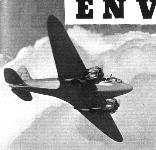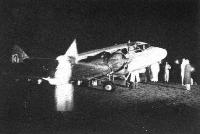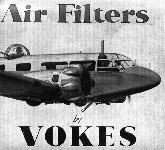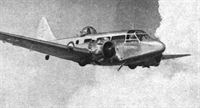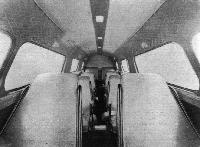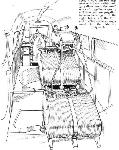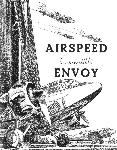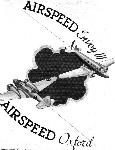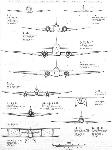
Описание
Страна : Великобритания
Год : 1934
Девятиместный легкий транспортный самолет
Варианты
- Airspeed - Envoy / AS.6 - 1934 - Великобритания
- Airspeed - Viceroy / AS.8 - 1934 - Великобритания
Airspeed AS.6 Envoy
Проектирование самолета, получившего обозначение Airspeed AS.6 Envoy, началось в конце 1933 года. Он был задуман, как дальнейшее развитие удачного AS.5 Courier, увеличенного в размерах и оснащенного двумя двигателями. Прототип впервые поднялся в воздух 26 июня 1934 года. Всего было построено 49 самолетов этого типа.
В стандартной компоновке Envoy вмещал одного пилота и до восьми пассажиров. Самолет имел цельнодеревянную конструкцию, с фанерной обшивкой, за исключением обтянутых полотном рулевых поверхностей. Особенностями машины были переставной стабилизатор и убирающиеся основные стойки шасси. Самолет выпускался с 1934 по 1939 год в трех модификациях. Первая, AS.6 Envoy Series I (построено 17 машин), не имела закрылков. На AS.6 Envoy Series II (13 машин) ввели разрезные закрылки. Третья модификация, AS.6 Envoy Series III (19 машин), была похожа на Series II, но в ее конструкцию внесли множество мелких доработок. В качестве силовой установки на Envoy могли использоваться различные поршневые двигатели воздушного охлаждения разной мощности и разных производителей.
Самолеты Envoy экспортировались в Китай, Чехословакию, Францию, Индию и Японию. Для военных целей они использовались ВВС и ВМС Великобритании, а также южноафриканскими ВВС. Несколько машин приняли участие в гражданской войне в Испании. Первый Envoy Series II, поставленный RAF, стал первым самолетом в Королевском авиаотряде.
Британские ВВС также приобрели две машины для службы связи в Индии и пять - для использования в той же роли в своей стране. По крайней мере один из них использовался во время Второй мировой войны ВМС, а еще три - ВВС. Южная Африка приобрела семь Envoy в 1936 году; три из них использовались ВВС и несли вооружение, включающее один неподвижный 7,7-мм пулемет для стрельбы вперед и один такой же пулемет на верхней турели. Четыре гражданские машины, принадлежавшие авиакомпании "South African Airways", можно было быстро переоборудовать для военного применения.
Специальный вариант AS.6, получивший обозначение AS.8 Viceroy, был построен для участия в воздушной гонке MacRobertson в 1934 году.
ТАКТИКО-ТЕХНИЧЕСКИЕ ХАРАКТЕРИСТИКИ
Airspeed AS.6J Envoy
Тип: девятиместный легкий транспортный самолет
Силовая установка: два мотора воздушного охлаждения Armstrong Siddeley Cheetah IX, взлетной мощностью по 350 л. с. (261 кВт)
Летные характеристики: максимальная скорость 338 км/ч на высоте 2225 м; крейсерская скорость 290 км/ч на высоте 3050 м; время набора высоты 3050 м - 8 минут; потолок 6860 м; дальность полета 1046 км
Масса: пустого снаряженного 1840 кг; максимальная взлетная 2858 кг; максимальная полезная нагрузка 625 кг
Размеры: размах крыла 10,52 м; длина 10,53 м; высота 2,90 м; площадь крыла 31,49 мг
Описание:
- Airspeed AS.6 Envoy
- Flight, July 1934
THE AIRSPEED "ENVOY" - Flight, January 1935
FOR FAST COMMERCIAL TRANSPORT - Flight, March 1936
FLAPPED EFFICIENCY - Flight, October 1938
British Commercial Aircraft
Фотографии
-
Flight 1934-07 / Flight
What the "Envoy" looks like on the ground. Landing lights are fitted in the leading edge of the wing of this machine, which was seen at the S.B.A.C. display at Hendon. The Wolseley engines are cowled with Townend rings.
-
Flight 1934-07 / Flight
Регистрационный номер: G-ACMT [11] AIRSPEED "ENVOY": This machine is fitted with two 185-h.p. Wolseley engines.
-
Jane's All the World Aircraft 1980 / Encyclopedia of Aviation - Aircraft A-Z - v1
Регистрационный номер: G-ACMT [11] Airspeed AS.6 Envoy.
-
Air Enthusiast 1996-09 / D.Ford - Oxford Graduate
Регистрационный номер: G-ACMT [11] The AS.6 Envoy prototype G-ACMT was first flown on June 26, 1934 and set Airspeed onto the successful twin-engined multi-use course.
-
Aeroplane Monthly 1978-09 / D.Middleton - Airspeed's elegant Envoy (1)
Регистрационный номер: G-ACMT [11] -
Flight 1934-09 / Flight
Регистрационный номер: G-ACMT [11] PERFECT LINES: The Airspeed "Envoy" (two Wolseley A.R.-9 engines) flying over Portsdown Hill. This machine carries 8 passengers with 240 lb. of luggage at a cruising speed of 150 m.p.h.
-
Aeroplane Monthly 1978-09 / D.Middleton - Airspeed's elegant Envoy (1)
Регистрационный номер: G-ACMT [11] WITH WHEELS UP: The Airspeed "Envoy" (2 Wolseley A.R.9 engines) has the same type of retractable undercarriage as the "Courier."
Study of G-ACMT, the prototype Envoy, flying from Portsmouth in 1934, shortly after its maiden flight. -
Aeroplane Monthly 1993-05 / C.Prower - From Brisfit to Beverley (2)
Регистрационный номер: G-ACMT [11] Series 2 Envoy G-ACMT flying over the Queen Mary over Cowes Roads in March 1936. Aboard the Envoy were Messrs N. S. Norway and Airspeed designer A. Hessell Tiltman.
LINERS OF TWO ELEMENTS: This fine aerial picture of the Queen Mary was secured by Flight's photographer over Cowes Roads last week. The Series II Envoy - from which, incidentally, the Airspeed Company's joint managing directors, Mes N. S. Norway and A. Hessell Tiltman, were viewing the liner - was flown by Flt. Lt. C. H. A. Colman.
G-ACMT, the prototype Envoy, after being modified to AS.6G, the prototype Series II with Wolseley Scorpio engines. It is seen over Cunard's Queen Mary. -
Aeroplane Monthly 1978-09 / D.Middleton - Airspeed's elegant Envoy (1)
Регистрационный номер: G-ACMT [11] The Envoy prototype over the Queen Mary in March 1936, after modification to Series 2 standard with split flaps and Wolseley Scorpio Is.
-
Flight 1936-04 / Flight Advertisements
Регистрационный номер: G-ACMT [11] -
Aeroplane Monthly 1978-11 / D.Middleton - Airspeed's elegant Envoy (2)
Регистрационный номер: G-ACVH [4] The first production Envoy 1, G-ACVH, with Wolseley A.R.9 Mk I engines.
-
Flight 1936-06 / Flight Advertisements
Регистрационный номер: G-ACVH [4] -
Flight 1935-01 / Flight Advertisements
Регистрационный номер: G-ACVH [4] -
Aeroplane Monthly 1978-09 / D.Middleton - Airspeed's elegant Envoy (1)
Регистрационный номер: G-ACVH [4] The first production Envoy I, with Wolseley A.R.9 engines, at Kastrup Aerodrome, Copenhagen.
-
Jane's All the World Aircraft 1938 / 01 - The progress of the world in civil aviation during the year 1937-38
Регистрационный номер: G-ACVI [4], VH-UXM [4] Alverca Aerodrome (Lisbon). - German and British Transport Machines.
Другие самолёты на фотографии: Junkers Ju.52/3m - Германия - 1931
-
Aeroplane Monthly 1978-09 / D.Middleton - Airspeed's elegant Envoy (1)
Регистрационный номер: G-ACVI [4], VH-UXM [4] Envoy I G-ACVI joined Ansett as VH-UXM in 1936.
-
Aeroplane Monthly 1978-10 / D.Middleton - Airspeed's elegant Envoy (1)
Регистрационный номер: G-ACVJ [5] MODERN BRITISH DESIGN. - This view of the "Lynx"-engined Airspeed "Envoy," taken by a Flight photographer over Langstone Harbour, Portsmouth, admirably illustrates its "clean" lines.
The Lynx-engined demonstrator for R. K. Dundas Ltd, G-ACVJ, left for India in January 1935, piloted by Flt Lt H. C. Johnson and Sir Alan Cobham. -
Flight 1936-05 / Flight
Регистрационный номер: G-ACVJ [5] The Airspeed Envoy, with Siddeley Lynx or Cheetah, or with Wolseley Scorpio engines, has a high performance for a very modest power expenditure.
-
Flight 1935-04 / Flight Advertisements
Регистрационный номер: G-ACVJ [5] -
Flight 1935-01 / Flight Advertisements
Регистрационный номер: G-ACVJ [5] -
Flight 1935-01 / Flight
Регистрационный номер: G-ACVJ [5] A side view of the "Lynx"-engined "Envoy" R. K. Dundas Ltd. are the Airspeed agents.
-
Aeroplane Monthly 1978-10 / D.Middleton - Airspeed's elegant Envoy (1)
Регистрационный номер: G-ADAZ G-ADAZ Tynedale of North Eastern Airways taking off from Brooklands.
-
Flight 1937-06 / Flight Advertisements
Регистрационный номер: G-ADBA [2], P5778 [2] It is recognised that the business demands of airline operators are for the lowest possible operating costs. Accordingly the Airspeed "Envoy" is of particular interest because its robust construction reduces maintenance to a minimum; its medium powered engines, coupled with aerodynamically clean design give 20 or 30 miles more distance per hour and it flies steadily in all weather conditions so that schedules can be maintained without time loss. Money and time is saved when "Envoys" are operated.
-
Aeroplane Monthly 1978-10 / D.Middleton - Airspeed's elegant Envoy (1)
Регистрационный номер: G-ADBA [2], P5778 [2] G-ADBA was impressed into RAF service in January 1939 as P5778.
-
Aeroplane Monthly 1978-10 / D.Middleton - Airspeed's elegant Envoy (1)
Регистрационный номер: G-ADBB Envoy Series 1 G-ADBB Wharfedale of North Eastern Airways at Heston in 1935/36.
-
Aeroplane Monthly 1978-10 / D.Middleton - Airspeed's elegant Envoy (1)
Регистрационный номер: G-ADBZ Another North Eastern Airways machine, G-ADBZ Swaledale, at Croydon in January 1937.
-
Aeroplane Monthly 1978-11 / D.Middleton - Airspeed's elegant Envoy (2)
Регистрационный номер: G-ADCA [2] Envoy Series I G-ADCA was delivered to Portsmouth, Southsea and Isle of Wight Aviation Ltd in mid-1935.
-
Aeroplane Monthly 1988-03 / J.Stroud - Wings of Peace
Регистрационный номер: G-ADCA [2] Portsmouth Southsea & Isle of Wight Aviation's Lynx-powered AS.6A G-ADCA.
-
Flight 1936-05 / Flight Advertisements
SERVICE CEILING WITH FULL LOAD 24,000 FEET. Although it is not usual to fly at such high altitudes in Europe, a service ceiling, at such a height does ensure that the Envoy Series II at normal altitudes has a very good performance with a rate of climb and single engine performance which gives a wide safety margin in cases of emergency.
-
Aeroplane Monthly 1993-05 / C.Prower - From Brisfit to Beverley (2)
Регистрационный номер: G-ACMT [11] G-ACMT, the prototype Airspeed Envoy, makes a low pass over Portsmouth shortly after its first flight in June 1934. The retractable undercarriage was a novel feature.
-
Flight 1936-03 / Flight
The new Envoy is shown in cruising trim.
-
Flight 1936-04 / Flight Advertisements
The optimum altitude for the Airspeed Envoy is 10,000 feet and at this height the cruising speed at 62 1/2 maximum power is 175 m.p.h. and the range 650 miles, with normal tankage. The maximum speed is 210 m.p.h.
-
Flight 1936-06 / Flight
Envoy II, (two Wolseley Scorpios)
-
Flight 1936-05 / Flight Advertisements
The Envoy Series II has ample power for operating from aerodromes situated at high altitudes. For instance, at 6,000 feet with Cheetah IX engines, the take-off run, in a 5 m.p.h. wind, is approximately 300 yards, whilst if one engine should cut out at this height, the aircraft will still climb on full load at the rate of 50 feet per minute. The safety margin of the Envoy Series II is, therefore, very high, and is another factor of interest to Airline Operators.
-
Flight 1936-10 / Flight
The well-flapped Series II Airspeed Envoy in the act of landing at Heston.
-
Flight 1936-03 / Flight
Safe and slow: Flt. Lt. Colman makes a demonstration landing just over the Heston boundary marks.
-
Flight 1936-06 / Flight Advertisements
High speed cruising has been demonstrated very effectively recently by two Airspeed Envoys fitted with Wolseley Scorpio engines. Visiting the Stockholm Exhibition one machine covered 3,381 miles in 23 hours, without the engines being touched. Fuel consumption was 22 gallons per hour, oil consumption 2 quarts per hour. The engines were fitted with self starters and it was not even necessary to turn the propellers by hand to suck in.
-
Flight 1935-06 / Flight
IN THE FLOODLIGHTS: This photograph, taken by a Flight photographer at Heston during the Household Brigade display, gives some idea of the value of modern floodlighting equipment. Those at Heston, of course, are of Chance manufacture, and the machine is an Airspeed "Envoy"
-
Flight 1935-01 / Flight Advertisements
The "Overseas Envoy" with its Townend ring-cowled "Lynxes."
-
Flight 1936-01 / Flight Advertisements
THE SERIES II AIRSPEED "ENVOY"
-
Flight 1936-03 / Flight
In three sections extending right across the centre section, the Airspeed split flaps are hydraulically operated.
-
Flight 1936-02 / Flight Advertisements
Регистрационный номер: G-ACMT [11] -
Flight 1935-01 / Flight
Sir Alan Cobham (right) with his pilot, Flt. Lt. H. C. Johnson, who is flying the "Envoy" to India.
-
Flight 1935-04 / Flight
The "Envoy" at Heston. From left to right can be seen Col. Boyle, Mrs. Anthony Eden, Ald. W. Hemmingway (the Mayor of Leeds), Ald. F.H.O'Donnell, Lord Grimthorpe (Chairman of North-Eastern Airways) and Col. Cameron.
-
Flight 1938-09 / Flight
AIR MARSHAL SIR PHILIP JOUBERT DE LA FERTE (Air Officer Commanding, R.A.F., India) and F/O King on the occasion of the Air Marshal’s visit to the Airspeed works to take delivery of the first of two Envoys for India
-
Flight 1936-09 / Flight
Mr. Ken Waller and Capt. Max Findlay investigate the construction of their Cheetah IX Airspeed Envoy at Portsmouth.
-
Flight 1937-03 / Flight Advertisements
Maintenance Cost of the AIRSPEED ENVOY 1-25 pence per mile
-
Flight 1936-10 / Flight
One of the Envoy's moderately supercharged Cheetah IXs en neglige on Saturday night
-
Aviation Historian 34 / M.Wickstead - Czechoslovakia's "Carefully Serving Airline"
Регистрационный номер: OK-BAL [4] The first of CSA’s fleet of four Airspeed Envoys, Mk I OK-BAL arrived in Prague in August 1935, followed by Mk I OK-BAM the following month. The two remaining Envoys, Mk IIs OK-BAN and ’BAO, were delivered in 1936, all four of the airline’s Envoys being powered by Czechoslovakian-built 340 h.p. Walter Castor II radials.
-
Aeroplane Monthly 1988-03 / J.Stroud - Wings of Peace
Регистрационный номер: OK-BAL [4] CSA AS.6E OK-BAL, with Walter Castor II engines. It was delivered in August 1935.
-
Aeroplane Monthly 1978-10 / D.Middleton - Airspeed's elegant Envoy (1)
Регистрационный номер: OK-BAL [4] OK-BAL was one of four Envoys supplied to the Czech airline, CSA, during 1935/36.
-
Aeroplane Monthly 1977-01 / G.Endres - Czechoslovakian Air Transport since 1920 (1)
Регистрационный номер: OK-BAL [4] Airspeed. A.S.6E Envoy III OK-BAL, above, was one of four used by CSA on their service to Moscow, inaugurated on September 2, 1936. It ended its life in the Finnish Air Force, being damaged beyond repair on July 31, 1943.
-
Flight 1936-12 / Flight Advertisements
Регистрационный номер: OK-VIT [3] -
Flight 1937-01 / Flight Advertisements
Регистрационный номер: OK-VIT [3] ENVOY III with stressed skin, ply covered wings, maximum weight 6400 lbs. and maximum speed 205 m.p.h.
-
Flight 1937-01 / Flight Advertisements
Регистрационный номер: OK-VIT [3] The Series III Envoy, incorporating a stressed skin ply covered wing structure, is being built in large batches, thus ensuring even earlier delivery dates than those previously quoted.
-
Flight 1938-09 / Flight
Регистрационный номер: VH-UXM [4], G-ACVI [4] Ansett Airway’s Airspeed Envoy (Wolseley Aries) over Melbourne, with the Shrine of Remembrance (which is quite near the Air Board H.Q.) in the background, and Government House to the left. This machine was originally owned by Lord Nuffield and was flown by Sqn. Ldr. Hilton from Capetown to Croydon in fast time.
-
Flight 1934-11 / Flight
Регистрационный номер: VH-UXY FOR PACIFIC FLIGHT: The twin-engined Airspeed "Envoy" monoplane, in which Mr. C. T. P. Ulm and Mr. G. M. Littlejohn propose to fly from Canada across the Pacific to Australia, being shipped at Southampton for Montreal.
-
Flight 1936-11 / Flight
Регистрационный номер: VT-AHR This particular Airspeed Envoy has just been delivered to the Maharajah of Jaipur.
-
Aeroplane Monthly 1988-03 / J.Stroud - Wings of Peace
Регистрационный номер: J-BDBO This Japan Air Transport Envoy was probably the second of JAT's Airspeed-built aircraft. Others were built by Mitsubishi.
-
Jane's All the World Aircraft 1938 / 03 - All the world's aeroplanes
Регистрационный номер: J-BDEO The Mitsubishi "Hinazuru" (Airspeed license) Commercial Monoplane (two 240 h.p. Mitsubishi "Lynx" engines).
-
Aeroplane Monthly 1978-10 / D.Middleton - Airspeed's elegant Envoy (1)
Регистрационный номер: J-BEYG BRITISH ABROAD: One of the Japan Air Transport Company's Airspeed Envoys on the tarmac at Haneda airport, Tokyo. Routes covering some 652,500 miles in the year are now operated regularly by this company - including a service to Manchukuo.
Envoy J-BEYG of the Japan Air Transport Company, seen at Haneda Airport, Tokyo, in 1936. -
Flight 1938-02 / Flight
Hts Majesty arrives in the Royal Airspeed Envoy and salutes as the Royal Standard is broken.
-
Flight 1937-11 / Flight
ON HIS MAJESTY'S SERVICE: The Air Council's Airspeed Envoy, used by members of the Royal Family, framed by the forepart of a Handley Page Harrow heavy bomber.
Другие самолёты на фотографии: Handley Page Harrow / H.P.54 - Великобритания - 1936
-
Flight 1936-11 / Flight Advertisements
The Airspeed ENVOY may be operated as a luxurious four-seat private owner aircraft, or as a six-seat, or eight-seat passenger aircraft. In both the four-seat and six-seat arrangement, a toilet is provided at the rear of the cabin. All are fitted with split trailing edge flaps and the Airspeed patent retractable undercarriage, the reliability of which has been tested thoroughly in all parts of the world.
-
Flight 1938-04 / Flight
The Airspeed Convertible Envoy shows great versatility in military and commercial fields. Two Siddeley Cheetahs are normally specified.
-
Flight 1937-01 / Flight
An Airspeed Envoy fitted with Siddeley Cheetah IX engines in which form it is capable of 205 m.p.h.
-
Flight 1937-04 / Flight Advertisements
The "Envoy" has been designed for high and economical cruising speeds. The Airspeed type of wood construction also ensures very low maintenance and C. of A. costs and has been thoroughly proved in the most varied climates from extreme cold to the humidity and heat of tropical countries.
-
Flight 1937-02 / Flight Advertisements
Another long delivery flight PORTSMOUTH - HONG KONG emphasizes the reliability of the ENVOY. In fourteen days - during several of which no flying was possible owing to waterlogged aerodromes and bad weather - a Series III Cheetah IX Envoy has completed a delivery flight to Hong Kong. It was fully loaded to 6400 lb. and had a range of 1000 miles. This again proves the unfailing reliability of the Cheetah IX Envoy III.
-
Flight 1937-08 / Flight
Регистрационный номер: G-AEXX [6], L7270 [6] THE KING'S ENVOY: One of the first flying views of the specially prepared Airspeed Envoy Series III (two Armstrong Siddeley Cheetah Xs) which is maintained for the transport of Royalty and State personages. The top speed is over 200 m.p.h. This particular machine belongs to the King’s Flight.
-
Flight 1938-05 / Flight
Регистрационный номер: G-AEXX [6], L7270 [6] THE KING’S ENVOY: A pleasing impression of the Royal Airspeed Envoy (two Armstrong-Siddeley Cheetah IX), in which His Majesty toured between four representative Royal Air Force stations last Monday.
-
Aeroplane Monthly 1978-11 / D.Middleton - Airspeed's elegant Envoy (2)
Регистрационный номер: G-AEXX [6], L7270 [6] Perhaps the most celebrated Envoy of all was Series 3 G-AEXX, ordered in 1937 as a VIP transport for the King's Flight. It flew as L7270 during the war.
-
Jane's All the World Aircraft 1938 / 03 - All the world's aeroplanes
Регистрационный номер: G-AEXX [6], L7270 [6] The Airspeed "Envoy" Monoplane (two 375 h.p. Armstrong Siddeley "Cheetah IX" engines).
-
Мировая Авиация 20
Регистрационный номер: G-AEXX [6], L7270 [6] Имевший просторную кабину на восемь пассажиров и отличный обзор для пилота, Envoy был выбран для коммерческой эксплуатации рядом стран, включая Англию, Японию, Китай и Южную Африку.
-
Aeroplane Monthly 1985-11 / A.Bennett - Fit for a king (1)
Регистрационный номер: G-AEXX [6], L7270 [6] View of the King’s Flight Airspeed Envoy G-AEXX, operated by the flight from May 1937 until October 1939.
-
Air-Britain Archive 1980-03
Регистрационный номер: G-AENA [6] The Airspeed Envoy Series III G-AENA Gabrielle in October 1936, ready for the Portsmouth to Johannesburg race.
The Airspeed Envoy III is normally powered by two Siddeley Cheetah engines of 350 h.p. each, but other makes can be fitted if desired.
G-AENA was in fact the first A.S.6J Envoy III with internal long-range tanks and Cheetah IX engines beneath the distinctive cowlings. It was named "Gabrielle" by its two owners who entered it for the Schlesinger Race from Portsmouth to Johannesburg. -
Aeroplane Monthly 1977-06 / J.Griffin - Portsmouth Airport 1932-1973
Регистрационный номер: G-AENA [6] TRANSPORT RACING: The one machine in the South African race which is equipped as a long-distance machine should be equipped - Waller and Findlay's Envoy. In addition to the safety provided by two Siddeley Cheetah IX engines and full blind-flying equipment, this machine has Marconi two-way and D/F radio and carries a radio operator.
Unlucky No 13. Airspeed Envoy G-AENA at Portsmouth on the eve of the Portsmouth to Johannesburg Race in September 1936. The aircraft crashed at Abercorn in North Rhodesia, killing Max Findlay. -
Air-Britain Archive 1980-03
Регистрационный номер: G-AENA [6] Taking on fuel at Portsmouth 23.9.36, the race number 13 proved prophetic as G-AENA was to crash in Northern Rhodesia on 1.10.36 killing M.H.Findlay.
-
Flight 1936-09 / Flight
Регистрационный номер: G-AENA [6] No. 13, the Airspeed Envoy, is probably the most completely equipped machine in the race. The engines are Cheetah IXs.
-
Flight 1936-10 / Flight
Регистрационный номер: G-AENA [6] Yo-heave-ho! Modern version of the Volga boatman, seen on Monday.
-
Aeroplane Monthly 1977-06 / J.Griffin - Portsmouth Airport 1932-1973
Регистрационный номер: G-AENA [6] No 13. Airspeed Envoy G-AENA in company with Percival Mew Gull ZS-AHO, Baragwanath at Portsmouth on the eve of the Portsmouth to Johannesburg Race in September 1936.
Другие самолёты на фотографии: Percival Mew Gull - Великобритания - 1934
-
Aeroplane Monthly 1984-05 / Personal album
Регистрационный номер: N9018, N9107 [2], G-AFJD [2], G-AFJE Three RAF aircraft at Lahore in 1938. On the right is Airspeed Envoy N9107 of the Delhi Communication Flight. In the centre is Hawker Audax K4862, which flew with Nos 20 and 39 Sqns before diving into the ground at Risalpur in May 1939. At left is Envoy N9018, also of the Delhi Communications Flight and previously G-AFJE. This aircraft crashed at Mingaladon in Rangoon in February 1942.
Другие самолёты на фотографии: Hawker Audax - Великобритания - 1931
-
Aeroplane Monthly 1984-05 / Personal album
Регистрационный номер: N9107 [2], G-AFJD [2] A fine study of the Airspeed Envoy N9107, photographed at Lahore in 1938. This aircraft was initially registered as G-AFJD to the High Commissioner for India in August 1938. In the same month the Envoy Series III passed to the Delhi Communication Flight and was based at Willingdon Airport.
-
Jane's All the World Aircraft 1938 / 01 - The progress of the world in civil aviation during the year 1937-38
ON THE WAY ACROSS INDIA. - An Airspeed "Envoy" being refuelled at Jodhpur.
-
Jane's All the World Aircraft 1938 / 01 - The progress of the world in civil aviation during the year 1937-38
FRIENDLY LITTLE AKYAB. - Snapped during a lull between storms. The rainfall averages 8 inches per day, which means much more at times.
-
Flight 1936-10 / Flight
A floodlight view of the Airspeed Envoy (No 13, Findlay and Waller) on the line in the dawn of Tuesday morning.
-
Jane's All the World Aircraft 1938 / 01 - The progress of the world in civil aviation during the year 1937-38
DELIVERED DULY. - An Airspeed "Envoy" at the Military Aviation Training Station at Lai-chow before the Japanese came within range.
-
Aeroplane Monthly 1978-11 / D.Middleton - Airspeed's elegant Envoy (2)
Регистрационный номер: G-AHAC, P5626 Envoy Series 3 G-AHAC did not join the civil register until April 18, 1946. It began life as P5626, one of five for the RAF, and was scrapped at Tollerton in May 1950.
-
Aeroplane Monthly 1978-11 / D.Middleton - Airspeed's elegant Envoy (2)
Регистрационный номер: ZS-AGD [2] Convertible Envoy ZS-AGD Alexander Biggar for South African Airways during trials at Martlesham Heath before shipment to Cape Town.
-
Aeroplane Monthly 1988-03 / J.Stroud - Wings of Peace
Регистрационный номер: ZS-AGB One of South African Airways' AS.6JC Convertible Envoys.
-
Aeroplane Monthly 1978-10 / D.Middleton - Airspeed's elegant Envoy (1)
Регистрационный номер: ZS-ALD ZS-ALD was one of four convertible Envoys used by South African Airways.
-
Air-Britain Archive 1980-01
Регистрационный номер: ZS-AGD [2] The article offers new evidence about the constructor's numbers of the Airspeed Envoys exported to South Africa. Here is the civil version ZS-AGD "Alexander Biggar" on 28.12.36.
-
Flight 1940-02 / Flight
Регистрационный номер: ZS-AGA [2] At the Rand Airport, Germiston. The aeroplanes are two Junkers Ju. 52s and an Airspeed Envoy.
Другие самолёты на фотографии: Junkers Ju.52/3m - Германия - 1931
-
Jane's All the World Aircraft 1938 / 01 - The progress of the world in civil aviation during the year 1937-38
TRANSVAAL. - One of the three Airspeed "Envoys" (350 h.p. "Cheetah IX" motors) of South African Airways Ltd. on the apron at the Rand Airport, Johannesburg.
-
Flight 1936-06 / Flight Advertisements
Conversion from luxury air liner into fast medium bomber, by four men in eight hours, is the outstanding feature of the latest type Airspeed Envoys, as supplied to the Government of the Union of South Africa. The wisdom of equipping air line personnel with this type of aircraft is most apparent when it is realised that in peace time pilots will become thoroughly familiar, in all weather and load conditions, with the type of aircraft they would be called upon to fly in time of war.
-
Мировая Авиация 20
Несколько самолетов Envoy ВВС Британии и Южной Африки были оснащены бомбодержателями и получили вооружение, состоящее из курсового и турельного пулеметов.
-
Flight 1936-07 / Flight Advertisements
PERFORMANCE and CONVERSION. The New Envoy is the first British aircraft built for rapid conversion from a commercial into a military machine with a performance equal to, if not better than machines designed wholly for military purposes.
-
Aeroplane Monthly 1978-09 / D.Middleton - Airspeed's elegant Envoy (1)
The first of three military Convertible Envoy Series 2s ordered for the South African Air Force was 251, seen here flying near Portsmouth in 1936. It left to fly the 7,000 miles to Johannesburg on July 4, 1936, accompanied by civil Envoy ZS-AGA.
-
Flight 1939-02 / Flight
One of the Airspeed Convertible Envoys two Siddeley Cheetah) supplied to the South African Government.
-
Air-Britain Archive 1981-02
Original C of A documents in SAAF records confirm that the C/n - serial tie-up of the AS.6J Envoys is indeed as recorded in Archive. The serials were added to the documents in South Africa. Thus Envoy '251' in the accompanying photo was actually c/n 50.
-
Air Enthusiast 1996-09 / D.Ford - Oxford Graduate
Envoy 251 of the South African Air Force showing the evolution into a general purpose military aircraft.
-
Aeroplane Monthly 1993-05 / C.Prower - From Brisfit to Beverley (2)
South African Air Force Convertible Airspeed Envoy III 251 on test from Portsmouth on June 28, 1936.
-
Flight 1936-07 / Flight
Were it not for the rear gunner's turret it would be impossible to distinguish this military version of the Envoy from its civil counterpart. The covered forward gun trough can be seen below the control cabin.
-
Flight 1936-08 / Flight Advertisements
Регистрационный номер: ZS-AGA [2] An important feature of the new Airspeed Convertible Envoys is the rapidity with which the aircraft can be converted from purely civil aeroplanes into fast bombers, or reconnaissance machines. This conversion can be carried out by four men in four hours and gives an additional value to high performance.
-
Flight 1936-08 / Flight Advertisements
The maximum speed of the Convertible Envoy - 210 m.p.h. - is proportionately equalled by the speed with which the aircraft can be converted from civil into military form. The conversion is carried out by four men in four hours. Now that re-arming occupies such a prominent position in Government programmes, throughout the world, the Convertible Envoy is of particular interest.
-
Air-Britain Archive 1980-01
The article offers new evidence about the constructor's numbers of the Airspeed Envoys exported to South Africa. Here is SAAF '251', a convertible model, seen over Portsmouth on 30.10.36
-
Aeroplane Monthly 1978-10 / D.Middleton - Airspeed's elegant Envoy (1)
The field of fire provided for the rear gunner can be visualised in this picture, which also shows the useful fact that the undercarriage, when retracted, can still be used for emergency landings on rough ground.
Convertible Envoy 251 for the South African Air Force poses for Flight on June 26, 1936. -
Flight 1936-07 / Flight
Although actually flying at 10,000 ft above the thunder clouds, Flt. Lt. Colman lowers the undercarriage and flaps of the first South African Envoy for the benefit of Flight's photographer.
-
Jane's All the World Aircraft 1938 / 03 - All the world's aeroplanes
The Airspeed Convertible "Envoy" in its Military form (two Armstrong Siddeley "Cheetah IX" engines).
-
Aeroplane Monthly 1978-11 / D.Middleton - Airspeed's elegant Envoy (2)
Convertible Envoy 251 for the SAAF at Martlesham Heath for tests. The patch covering the forward-firing machine gun on the starboard side of the nose has been removed.
-
Aeroplane Monthly 1978-10 / D.Middleton - Airspeed's elegant Envoy (1)
The second of the three SAAF Envoys was 252, seen here during World War Two.
-
Aeroplane Monthly 1979-01 / Personal album
Регистрационный номер: G-AERT Airspeed Envoy 41-1 during the Civil War. The letter “T” forward of the fuselage band and the “E” inboard of the band on the starboard wing suggest that this aircraft was originally G-AERT/ c/n 68, recorded as being "sold abroad" in April 1937. Other pictures of the same aircraft reveal the “G-A” prefix of its British registration on the port wing. Another Envoy which flew for Franco was G-ADBB, whose identity could be clearly discerned beneath its camouflage paint.
-
Flight 1936-08 / Flight
A panel-type Vokes air filter as applied to a Cheetah IX installation on a convertible Airspeed Envoy for South Africa.
-
Flight 1934-12 / Flight
SLIPPERS : The "Envoy's" equipment.
-
Flight 1936-11 / Flight
AIRSPEED INNOVATION. The new Series III Airspeed Envoy incorporates stressed-skin, plywood-covered wings of simplified construction. This view shows one of the first "going through.''
-
Aeroplane Monthly 1978-04 / D.Middleton - Courier Airspeed's innovator (2)
Envoys in production at Portsmouth, with the Air Ministry's Courier K4047, minus wings, at right.
Другие самолёты на фотографии: Airspeed Courier / AS.5 - Великобритания - 1933
-
Aeroplane Monthly 1978-11 / D.Middleton - Airspeed's elegant Envoy (2)
Регистрационный номер: G-ACVI [4], VH-UXM [4] Envoy production at Portsmouth in 1934. Note Courier K4047 behind.
Другие самолёты на фотографии: Airspeed Courier / AS.5 - Великобритания - 1933
-
Flight 1935-06 / Flight Advertisements
"IT IS DIFFICULT TO IMAGINE ANY AEROPLANE WHICH ALLOWS A BETTER OUTLOOK FROM THE PILOT'S COCKPIT..."
-
Aeroplane Monthly 1978-11 / D.Middleton - Airspeed's elegant Envoy (2)
The pilot's position in the Envoy, in this case one with Lynx IVC engines. The handle on the right of the seat is for raising or lowering the undercarriage.
-
Flight 1934-07 / Flight
This is what you see when looking into the pilot's cockpit through the bulkhead door in the passengers' cabin.
-
Flight 1937-04 / Flight Advertisements
The view of the pilot's cockpit shows the Sperry Gyro Horizon and Reid & Sigrist Turn & Bank Indicator fitted on the Blind Flying Instrument Board. In addition, a Marconi Homing Device is shown with the Visual Indicator mounted on the windscreen at the top. The instrument immediately above the Gyro Horizon is the Undercarriage Pressure Gauge
-
Aeroplane Monthly 1978-11 / D.Middleton - Airspeed's elegant Envoy (2)
The interior of a Convertible Envoy of South African Airways. Behind and below the left-hand seat is an “Antifyre” extinguisher.
-
Flight 1935-01 / Flight
Looking aft in the "Envoy" Cabin. Let into the bulkhead is the Plessey A.C.44 wireless set.
-
Flight 1936-10 / Flight
The cabin tanks of the Airspeed Envoy. The two large ones which are visible hold 53 gallons each, the small one is of 10 1/2 gallons capacity and there are two 49-gallon tanks in the wings.
-
Flight 1936-10 / Flight
The D.F. and trailing aerial arrangement for the Marconi equipment.
-
Flight 1939-05 / Flight
The flying scale model - Airspeed Envoy
-
Flight 1937-11 / Flight Advertisements
While re-armament occupies such a prominent position in government programmes throughout the world, the Convertible Envoy is of particular interest. This aircraft is converted from a civil aeroplane into a fast medium bomber by four men in four hours.
-
Flight 1937-11 / Flight Advertisements
For passenger service the Convertible Envoy provides a fast luxurious form of travel with the same high standard of comfort as that provided in the normal civil Envoy. The fittings to which the military equipment is attached are not apparent to the eyes of the passengers and all interior military fittings are covered by upholstery.
-
Flight 1937-09 / Flight Advertisements
Другие самолёты на фотографии: Airspeed Oxford / AS.10 - Великобритания - 1937
-
Flight 1936-04 / Flight Advertisements
A cut-away view of the Envoy Series II arranged as a six seater with lavatory and luggage compartment. The Envoy is also arranged as a luxurious four seater or, by dispensing with the lavatory, an eight seater.
-
Flight 1934-07 / Flight
A general view of the centre section unit of the "Envoy" showing the two mountings for the Wolseley engines, and the circular plywood bracing between the spars.
-
Flight 1934-07 / Flight
A diagram of the retractable undercarriage of the "Envoy." When retracted the wheel protrudes about one third of its diameter beneath the wing. Both sides of this undercarriage are the same.
-
Flight 1934-10 / Flight
Другие самолёты на фотографии: Airspeed Courier / AS.5 - Великобритания - 1933Boeing Model 247 - США - 1933Douglas DC-1 / DC-2 / C-32 / C-39 - США - 1933Fairey Fairey IIIF - Великобритания - 1926Koolhoven FK-41 - Нидерланды - 1928Lockheed Orion 9 - США - 1931Messerschmitt Bf.108 Taifun - Германия - 1934Miles Hawk / M.2 - Великобритания - 1932Pander S-4 Postjager - Нидерланды - 1933
Тип фотографий
- Все фото (149)
- Ч/б фото (123)
- Кабина (13)
- Модели, рисунки, схемы, чертежи (13)


































